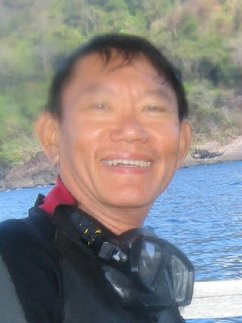Malapascua Dive, 10-15 Sept. 2010




The best photos were beneath the sea and these were by
my buddy and divemaster Ken Soh.
See his album at:
http://www.facebook.com/home.php?#!/album.php?aid=286812&id=653039679
This has been a most memorable trip scoring first for:
1. The worst checkout dive in 303 dives so far logged. A checkout dive is for divers to re-familiarise themselves with their equipment and the marine environment. It is always planned to be easy after a period of non-diving when anxiety is expected.
However, this checkout dive although never exceeded 20m. (average 16m) was against the current throughout the dive. The current got worse as the dive proceeded - what was the divemaster thinking?
I was in poor form, still suffering from a bad cough caught in the high passes of Tibet on the 12-30 Aug. trip, and it was unnerving to have to struggle even towards the end of the dive. I finished the dive completing my safety stop with a near empty tank of 6 bars (started with 200 bars, 1 bar = 14.5 lbs. per sq. in.)
2. My best cave dive (a gigantic swim-through to be technically accurate). Caves are prohibited for leisure divers unless certified for doing so after a special course (extremely demanding). It is extremely hazardous to venture into a cave and those that take up the special course are divers who have logged several hundred dives. However, this cave was open to leisure divers because the entrance was wide enough to enable five divers to swim abreast into the mouth. The exit on the other side of the island though narrower was also easy for an experienced diver.
Inside the cave the passage-way meandered and with my torch-light I could see the rich biodiversity of soft and hard corals, shrimps, craps, a giant puffer fish, a white and black banded sea-snake, three juvenile white-tip reef sharks and many species of nudibranch (sea-slugs).
3. The main aim of visiting Malapascua Island is the close encounter with thresher sharks. We have to wake up at 5am. to prepare for the dive. It took 40 mins. to reach the site at Monad Shoal and we descended at 5.50am to a depth of 17m. and just waited. Monad Shoal is a small atoll rising from the deep ocean floor of many hundred metres. Thresher sharks are pelagics and they live in deep oceans. Occasionally some would ascend and come to Monad Shoal to get rid of parasites infesting their skins by swimming around the atoll for small fishes like the bat fishes and Moorish idols to feast on the pests. It was just luck whether a diver could sight any and so we were on our knees, our eyes and camera strained in less than 10m. visibility towards the edge of the atoll - waiting and waiting.
The wait was not in vain. I saw 2 threshers on 12 Sept. and 4 on 14 Sept. The second occasion was the better one when two appeared in front of me and one at the back. To those who have a phobia about sharks please watch this video by my friend, Lea Meng, to see that thresher sharks are completly harmless and admire their grace and beauty.
http://www.facebook.com/video/video.php?v=10150090266987995#!/video/video.php?v=10150090266987995&subj=53573104
4. My most scary wreck dive on 13 Sept. With strong surface current we had to descend using the buoy-line. This was a dive done with enriched air of 32% oxygen (technically called NITROX EAN 32) which limited a depth to 32m. The current was even stronger at the bottom where the Dona Marilyn sank on Oct 1988 during typhoon Ruby. My air gauge showed a rapidly declining level of air going against the strong current and with a breathing rate of 5 bar/min. this showed high anxiety. I did reach the divemaster Paul at the stern who pointed out a marble ray resting at the bottom but my dive-computer was beeping frantically. I had exceeded the depth limit below 32m. and exposed myself to oxygen toxicity. I gave the OK signal to Paul and swam away, now looking for the buoy line which was no where to be seen. The dive-computer showed that the air level had dropped to 48 bars with only 28 mins. of diving. I immediately ascended slowly to 22m and held onto a protruding part of the wreck (the passenger ferry was lying on its side).
Wondering what to do next as my buddy was not in sight due to the poor visibility of 5m. It was a relief to see another team-mate and instructor Lea Meng below me. She saw me and signalled whether I was ok and I signalled back that I was low on air. Blessed her - she signalled me to follow her and brought me to the buoy line. I slowly make my way up and completed my safety stop with 14 bar of air left, my shortest dive of 34 mins.
5. Among this team of divers were a sister and younger brother, Melissa & Marcus. I had never dived with them before. They were young, younger than my children, yet I felt an affinity with them. It was only while having dinner after the last dive, during a warmth conversation, that Melissa mentioned her family and I discovered that she was the daughter of a dear classmate of mine who had passed away of cancer. I was delighted to see that my dear friend has brought up such fine children.
Serendipity - such a beautiful word.

